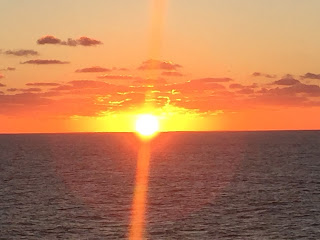October 7, 2016
We visited Cadiz on October 7, 2016. Cadiz is historically
important for many reasons, some of which are as follows:
1. It is one of the oldest cities in western Europe, having been
populated by every civilization all the way back to the Phoenicians;
2. It has always been the base for Spain's Navy and is close to
the site of the battle of Trafalgar;
3. Christopher Columbus left from Cadiz on two of his four voyages
to the new world; and,
4. Gym and Mrs Gym were there in 2016.
Location, location, location...Cadiz was built in the perfect
place. It was established at the end of a thin peninsula surrounded by water. Today, two big bridges help connect the city to the mainland but for thousands
of years the city's ongoing existence was guaranteed by its location. Cadiz has
until modern times, been very easy to defend. The evidence of various
civilizations thriving and surviving at this site are being dug up all the time
in property development and renovation projects. We saw some of that evidence
in the Cadiz Fine Arts and Archaeological Museum. There are particularly good
Roman and Phoenician exhibits there. The museum was part of a walking tour we
took around the old town.
Cadiz has retained its charm as the local governments have wisely limited the development of high-rise buildings.
This has kept the narrow streets and old town squares popular places for
tourists and locals alike. A walking tour is really the only practical way of
seeing most of the sites, since many areas are not accessible to vehicles
bigger than scooters. In this very walkable city, Gym and Mrs. Gym easily
chalked up 10,000 steps on the day.
After the tour and some exploration on their own, the intrepid couple re-boarded the vessel for the last time from
the European mainland just before dinner on October 7, 2016. They settled in for a
36-hour crossing from the mainland to the island of Madiera, Portugal.
Even before leaving the European continent, thanks to the
internet, the author was able to use NOAA, The Weather Network and other such
sites to track Hurricane Matthew and a yet to be named low pressure system in
the Caribbean Sea. Appropriately, that unnamed storm would be named Nicole (our
daughter's name) as the tropical depression became a tropical storm and then
started moving in a northerly direction, in the easterly wake of her big
brother Matthew.
 |
| The Old City Wall of Cadiz |
 |
| The use of marble tiles again in an urban park |
 |
| Plaza San Juan de Dios leading to the Old Town Hall |
 |
| Statue to Segismundo Moret, a Spanish politician (his mother was Irish) |
 |
| The Od Town Hall |
 |
These officials are coming out of city hall to join a procession
that will wind through the streets and end up at a Church where flowers will
be placed in honour of the Virgin Mary |
 |
Oyster stone is the primary building block of Cadiz. It is sandstone that
contains pieces of the shells from ancient shellfish. |
 |
An interesting use of a used cannon barrels is shown
in this picture. They were used to keep carriage wheels
from hitting the corners of buildings |
 |
| ballast stones were used as pavement on many of the streets |
 |
| What are the white markings in the stone of this plaza? |
 |
Ignore the modern art in the centre of the picture and notice the front
door to a church in the background and the white markings on the floor of the plaza |
 |
The markings are are the floor plan or blueprint of the Cadiz Cathedral
laid out in front of the church itself |
 |
And here is the massive Cadiz Cathedral which took 116 years to complete.
Because it took so long it had several lead architects and exhibits
multiple architectural styles |
 |
The old city boasts 129 different watchtowers. Everyone in the 18th and 19th
centuries wanted to monitor incoming ships bringing wealth back from the new world |
 |
| The beach on the edge of old Cadiz. You are never far from a decent beach. |
 |
| the high rent district |
 |
| de Mora house (perhaps we are related) |
 |
| Plaza de San Antonio |
 |
The museum is located on the Plaza de Mina which is dominated
by the gigantic banyan tree populated by parakeets and other exotic birds |
 |
| Two Phoenician sarcophagi in the Cadiz Museum |
a
 |
| Phoenician artifacts found in Cadiz |
 |
A roman statue of Emperor Trajan from Cadiz now
safely in the museum |
 |
| You know you are not in Calgary when parakeets compete with pigeons |
 |
| approaching the monument to the Constitution of 1812 |
 |
a bad panorama of the Plaza de Espana and the monument to the
Constitution of 1812 |
 |
After pulling out of the docks this US Destroyer sped by.
The US Navy has a base near Cadiz |
 |
| Heading west into the open Atlantic 36 hours from Madeira |













































No comments:
Post a Comment